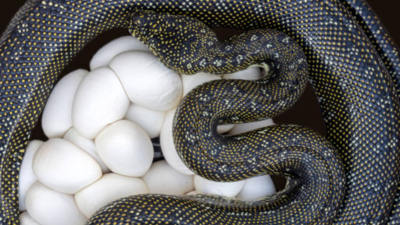ARTICLE AD BOX

So you're gardening, pulling weeds, maybe moving some rocks or checking on the compost pile, and then you see a small cluster of leathery-looking white eggs nestled in the dirt. They’re not chicken eggs.
They’re not bird eggs. And they’re definitely not the Easter Bunny’s leftovers. Congratulations (or sorry), you might have stumbled upon snake eggs.If that just gave you the chills, you’re not alone. Finding snake eggs in your backyard can feel like something straight out of a horror movie, but it's actually more common than most people realize—especially during the warmer months when snakes are laying and nesting.
The good news? You can learn how to spot these eggs before they hatch and tiny snakes start slithering around your garden.Let’s break down the basics.
Where do snakes lay eggs?
Most snakes are pretty private about laying eggs. They look for warm, damp, and hidden places to lay their eggs—think under logs, inside compost heaps, beneath rock piles, or tucked deep into your mulch bed. If you’re cleaning out an old shed or flipping over bricks in your yard, don’t be surprised if you find a hidden clutch.
Keep in mind: not all snakes lay eggs. Some, like rattlesnakes and garter snakes, give live birth. But egg-layers like rat snakes, king snakes, and corn snakes? They could definitely be leaving a nursery behind your flowerbed.
What do snake eggs look like?
Here’s what makes them stand out:Shape and texture: Unlike hard bird eggs, snake eggs are soft, leathery, and slightly squishy. They feel kind of like a soft rubber balloon. They're usually elongated or oval, not round.Color: Most snake eggs are off-white or cream-colored. If they’ve been sitting for a while, the surface may look a little dry or dusty.Clustering: Snakes don’t lay eggs one at a time. If you find a group of 5 to 20+ eggs, chances are it’s a clutch. They’re often stuck together in a little bundle.Size: Most snake eggs are around 1 to 2 inches long, though this can vary by species.Here’s the kicker—if you’re not sure, don’t poke.
It’s tempting, especially if you’re a curious soul, but disturbing the eggs can harm developing embryos (if they’re snake eggs) or spread bacteria (if they’re something else).
Found eggs? What should you do?
Let’s say you’ve identified a suspicious clutch in your garden. Now what?Don't panic. Not all snakes are dangerous. Many are beneficial for controlling pests like rodents.Don’t move the eggs yourself, unless you absolutely have to. Mishandling them can damage the embryo or lead to hatching in your garage (true story).Call a local wildlife expert or animal control. They can safely relocate the eggs if needed.Keep pets and kids away from the area until it’s sorted out.Snakes may seem scary, but most are just trying to survive—just like you. And believe it or not, having non-venomous snakes in your yard is a sign of a healthy ecosystem. Still, we get it—surprise snake babies are not everyone’s idea of backyard bliss.So next time you stumble across mysterious eggs while doing yard work, take a second look. Soft, leathery, oval, and tucked in a hidden spot? You might just be looking at the next generation of slithery neighbors.And if you’re still not sure? When in doubt, call in the pros before they hatch.



.png)
.png)
.png)
















 3 hours ago
5
3 hours ago
5









 English (US) ·
English (US) ·